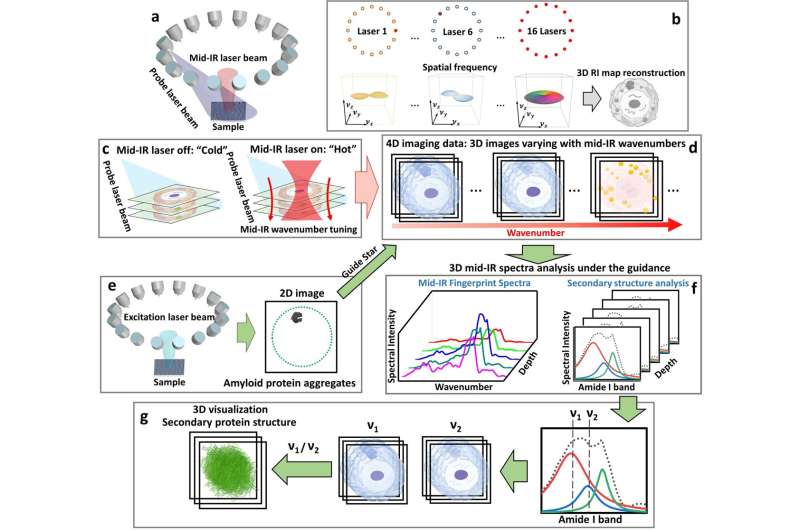This article has been reviewed according to Science X's editorial process and policies. Editors have highlighted the following attributes while ensuring the content's credibility:
fact-checked
peer-reviewed publication
trusted source
proofread
Computational mid-infrared photothermal imaging unveils intracellular tau aggregates

As a prominent form of amyloid protein, tau aggregates have emerged as a primary focus of research for uncovering the mechanisms underlying neurodegeneration. Various types of tau aggregates, including tau fibrils and oligomers, have been implicated in a wide range of neurodegenerative diseases. However, the formation mechanism of tau aggregates and the associated disease pathways remain poorly understood.
Investigating tau aggregation necessitates high-resolution chemical imaging tools capable of characterizing intracellular volumetric tau aggregates within their native environments. Several approaches have been developed for this purpose, such as X-ray crystallography, cryo-electron microscopy (Cryo-EM), nuclear magnetic resonance spectroscopy, circular dichroism spectroscopy, and atomic force microscopy-based infrared spectroscopy imaging.
These methods have made significant strides in characterizing various types of amyloid proteins, including tau aggregates. Nonetheless, the existing solutions are fundamentally constrained by their inability to provide volumetric site-specific spectroscopic analysis and three-dimensional imaging of intracellular protein aggregates in their native cellular states. Therefore, the challenge of recovering three-dimensional chemical information of intracellular protein aggregates in their native cellular environments remains a significant obstacle.
In a recent publication in Light Science & Applications, Dr. Ji-Xin Cheng from the Photonics Center at Boston University, Dr. Jian Zhao (former member of the Cheng Lab at Boston University) from the Picower Institute for Learning and Memory at the Massachusetts Institute of Technology, Dr. Benjamin Wolozin from the School of Medicine at Boston University, Dr. Lei Tian from the Department of Electrical and Computer Engineering at Boston University, and their colleagues present a computational fluorescence-guided mid-infrared (mid-IR) photothermal microscope known as Fluorescence-guided Bond-selective Intensity Diffraction Tomography (FBS-IDT). FBS-IDT integrates single-photon 2D fluorescence imaging into pump-probe pulsed MIP intensity diffraction tomography. This innovative technique enables molecular-specific 3D chemical imaging and site-specific mid-IR spectroscopic analysis of intracellular tau fibrils within the cellular fluid.
Specifically, FBS-IDT enables efficient extraction of chemical information regarding specific protein aggregates from background protein signals within cellular fluids. FBS-IDT's 3D spectroscopic imaging can achieve high speed (~0.05 Hz, up to ~6 Hz) and high resolutions (~350 nm laterally, ~1.1 µm axially). Leveraging this hyperspectral 3D chemical imaging capability, FBS-IDT demonstrates the potential correlation between tau fibrils and lipid accumulation. Notably, this technique is capable of extracting depth-resolved mid-IR fingerprint spectra and visualizing the protein secondary structure of intracellular tau fibrils in three-dimensional space.
The scientists underscored the significance and advantages of the FBS-IDT technique: "FBS-IDT overcomes the challenges associated with 3D chemical imaging of intracellular amyloid protein aggregates and their protein secondary structures within fluid environments. This accomplishment is realized through a scan-free and modular design that utilizes a low-cost brightfield microscope with add-on light sources. The cost of the FBS-IDT system is at least 30 times lower than that of state-of-the-art electron microscopy methods, such as Cryo-EM, and it incurs negligible operational fees. This cost-effective tabletop system is suitable for routine usage in most laboratory settings."
"Our technique imposes no additional restrictions on biological samples, thereby opening up a new avenue for in vivo imaging of intracellular protein aggregates. Furthermore, our method is built on a modular design that can be readily adapted to fulfill diverse imaging requirements. We firmly believe that our FBS-IDT method can offer novel contributions to neurodegeneration research and various biomedical applications." the scientists added.
More information: Jian Zhao et al, Mid-infrared chemical imaging of intracellular tau fibrils using fluorescence-guided computational photothermal microscopy, Light: Science & Applications (2023). DOI: 10.1038/s41377-023-01191-6
Journal information: Light: Science & Applications
Provided by Chinese Academy of Sciences



















